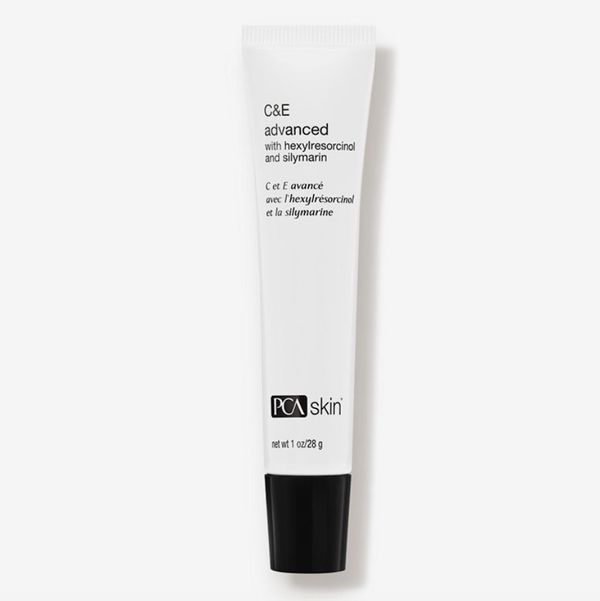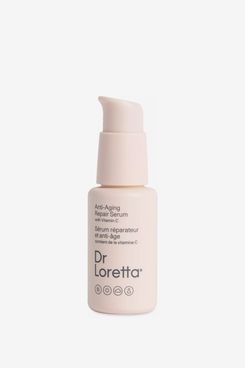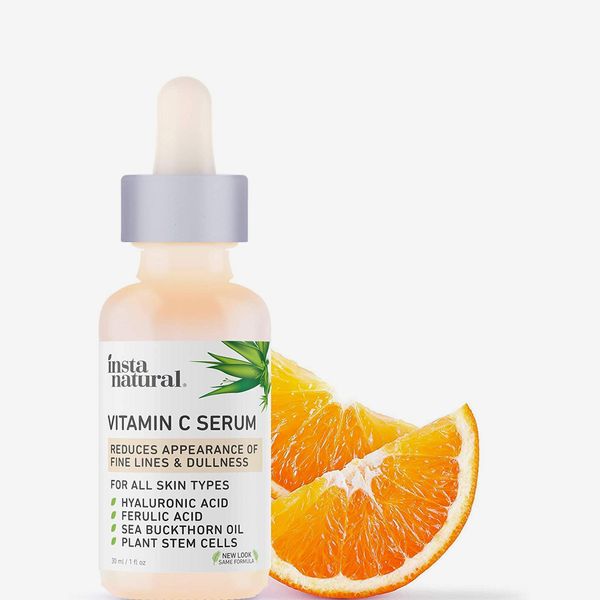
In this article
As someone with a fairly minimal skin-care routine, it’s difficult to convince me to add a new product or step. But vitamin C is one of those actually necessary ingredients. The antioxidant promises to do everything from fading dark marks to fighting free radicals (which break down collagen) to diminishing fine lines and wrinkles. It’s incredibly effective at all of this, which is why so many people use and recommend it. It’s also why there are so many products to choose from. But alas, nothing’s perfect. Despite its efficacy, vitamin C is notoriously unstable and can quickly go from a hyperpigmentation-zapping wonder ingredient to a $60 bottle of smelly serum. That’s why it’s important to find the right formulation — one that makes vitamin C as stable as possible while also delivering it effectively to the skin.
To find the best of the best, I tested a bunch of formulas — wearing the best overall pick off and on for a year. I tried newer launches, too, including the cult-favorite Hyper Skin, which I recommend. I also spoke to dermatologists, aestheticians, and Strategist staffers who moonlight as skin-care enthusiasts for recommendations. All of those picks — organized by skin needs and type — are below.
Updated on December 17, 2024: Updated prices and checked stock for all products.
What we’re looking for
Ingredients
Of all the vitamin-C options, our experts generally recommend looking for serums that contain ascorbic acid, also known as L-ascorbic acid, which is the most active and purest form of vitamin C. L-ascorbic acid is water soluble. While incredibly effective, it can be irritating for some people and even cause acne. If you fall into that category, are just starting out, or have sensitive skin, you can try vitamin-C derivatives, which Dr. Karan Lal says are “less irritating and more tolerable and more stable” forms of vitamin C. “L-ascorbic acid is the most active form of vitamin C, whereas the derivatives are inactive. They have to be converted to the active form and are less potent than the pure, active ingredient.” The difference between pure vitamin C and vitamin-C derivatives is similar to retinols and retinoids: Both work, but one is more concentrated and thus more effective. One of the most popular derivatives is tetrahexyldecyl ascorbate (often called THD-ascorbate), which is marketed as a more tolerable alternative that offers similar results. Unlike L-ascorbic acid, which is water soluble, THD-ascorbate is oil soluble and can be easily added into an oil-based product. The vitamin-C derivatives also easily penetrate the skin because the skin has a lipid barrier (think: oil dissolves oil), so there’s not as much resistance to the ingredients as something water soluble (like L-ascorbic acid). In recent years, products have come out containing both L-ascorbic and an accompanying derivative, which combines the unstable formulation with a more stable formulation — offering the best of both worlds. Lal also mentioned that more brands are formulating with additional forms of vitamin C like magnesium ascorbyl phosphate (MAP) and sodium ascorbyl phosphate (SAP), water-soluble derivatives that have been shown to be effective in lower concentrations and are fairly well tolerated by sensitive skin.
Formulation
All of our experts agree: Formulation is paramount to vitamin C’s stability. The more stable, the better, because you reap all of the glow-inducing benefits. “A product must be formulated carefully to enable sufficient delivery to the skin,” Dr. Kenneth Howe of the Wexler Dermatology Group explains. As for how much vitamin C should be in a given formulation, Lal recommends at least 10 percent. Less than that and you don’t get the full benefit of the product, and over 20 percent, you don’t get any additional benefits and are more likely to experience irritation. However, this doesn’t really mean much when it comes to derivatives because, according to Lal, once the derivatives hit the skin, a 10 percent concentration is much closer to 3 or 4 percent.
Packaging
Your vitamin C should come in a dark or opaque bottle. This helps prevent oxidation, which happens when it is exposed to sunlight or isn’t kept in an airtight bottle. It will be obvious that this is happening because the formula will darken in color. To prevent this, our experts recommend keeping it away from sunlight and storing it somewhere dark, along with closing the bottle tightly.
Best vitamin-C serum overall
Ingredients: Contains L-ascorbic acid, ferulic acid, and vitamin E | Formulation: 15 percent vitamin C | Packaging: Translucent amber bottle
SkinCeuticals C E Ferulic was explained to me, as a young beauty editor, as liquid gold. The one product you forsook all others for, the one you never gave away. Never mind the hot dog–water smell; that just meant it was potent and working. Naturally, when I got my hands on my first bottle, I was excited. And by the end of that bottle, I was hooked. It has been the gold-standard vitamin-C serum for years, so much so that lots of formulas (some of which are on this list) have mimicked the ingredients list, chasing the same results. But nothing beats the original.
I’ve been using C E Ferulic for the past few years, and in that time, it’s lightened up my dark marks and given me overall glowier skin. There are benefits I don’t necessarily see but believe in — like oxidative stress protection. I don’t struggle with excessive hyperpigmentation, and I like to think that this (along with consistent sunscreen use) helps with that. It’s also incredibly lightweight. Other formulas I’ve used sometimes react badly with my other skin-care products and pill, but this never does. Admittedly, it’s expensive, but it’s worth it, given that it’s formulated with a super-stable form of vitamin C. I’d rather spend close to $200 on a vitamin C I know is going to work rather than wasting money on a bunch of less-expensive products that may or not be doing their job. The vitamin-C formulation itself is patented, meaning that no matter what another brand’s ingredients list says, it isn’t the same. And dermatologists agree. Four of the dermatologists consulted recommended SkinCeuticals C E Ferulic, calling it the gold-standard vitamin-C serum that’s suitable for all skin types. “I think it’s the best out there,” declares Howe. He says it has a light, nongreasy feel while still delivering “the maximum amount of its active ingredients to the skin.”
Its main active ingredient is L-ascorbic acid (it comprises 15 percent of this serum), and despite the high concentration of pure vitamin C, it is stable and easily penetrates the skin. Part of this serum’s patented formula includes a pH level higher than those of its competitors, meaning it won’t cause the redness and sensitivity that serums with a lower pH can. As Dr. Julie Russak, founder of the Russak Dermatology Group, puts it, this serum “delivers vitamin C through the top layer without disrupting the protective barrier of the skin.”
Whatever vitamin-C serum you choose, Howe suggests applying it in the morning. “That way a reservoir of active vitamin C is present in the skin during the daylight hours, when ultraviolet radiation is strongest,” he explains.
Best less-expensive vitamin-C serum
Ingredients: Contains L-ascorbic acid, ferulic acid, and vitamin E | Formulation: 15 percent vitamin C | Packaging: Opaque bottle
For a more affordable option, there’s the Drunk Elephant C-Firma Day Serum, which I like because its format ensures maximum freshness. Vitamin C is prone to spoiling, especially when exposed to light, but Drunk Elephant separates the serum and a powdered form of vitamin C, so you can combine them when you’re ready. Doctors recommend it, too, with two of the consulted dermatologists name-checking it. Because it contains a similar formula to the SkinCeuticals C E Ferulic, you get all the skin-brightening benefits at “half the cost,” according to Dr. Noelani Gonzalez, a dermatology specialist at Mount Sinai Health System. But unlike SkinCeuticals, Drunk Elephant’s serum is cruelty-free. Its formula contains L-ascorbic acid as well as pumpkin-ferment extract and pomegranate enzyme, which attack dead surface-skin cells and help to exfoliate, explains Dr. Deanne Mraz Robinson, a co-founder of Modern Dermatology of Connecticut and skin-care company Pure BioDerm. Plus, the serum’s packaging is both airtight and completely opaque — things Gonzalez says you should look for when choosing a serum, because packaging like this helps to keep the vitamin C away from exposure to water, light, and oxygen (all of which degrade it). The only thing that makes it a less desirable option than the OG SkinCeuticals is the consistency — it can be a bit sticky, which makes it a little more difficult to layer with other products.
Best budget vitamin-C serum
Ingredients: Contains L-ascorbic acid, ferulic acid, hyaluronic acid, and vitamin E | Formulation: 15 percent vitamin C | Packaging: Translucent amber bottle
If you’re in search of a budget-friendly option, there’s Maelove’s Glow Maker, which has been touted as a C E Ferulic dupe. This serum has long been a cult favorite, beloved by everyone from former editor at the Cut Kathleen Hou to skin-care vloggers to Opening Ceremony employee Bettina Cho, whom Hou says “has a knack for discovering beauty products.” It also comes recommended by Russak, who likes that it has a “straightforward formula” that nourishes the skin. In addition to containing L-ascorbic and ferulic acids, it contains vitamin E (great for hyperpigmentation) and hyaluronic acid, which helps the skin to hold onto hydration. According to Hou, it’s also a bit thinner and less sticky, which makes it easier to spread and even more seamless under makeup or other skin-care products.
Best extra-strength vitamin-C serum
Ingredients: Contains L-ascorbic acid, vitamin E | Formulation: 20 percent vitamin C | Packaging: Opaque bottle
For skin that’s been proven to handle high amounts of vitamin C without irritation, this lightweight serum from PCA Skin is a good next step. It contains 20 percent L-ascorbic acid along with pure vitamin E and other antioxidants that help with aging and free radicals. Despite the high concentration of active ingredients, it’s very lightweight and nourishing. Dermatologist Dr. Elizabeth Tanzi loves it because the serum can “easily integrate into a skin-care regimen” and doesn’t cause irritation.
Best less expensive extra-strength vitamin-C serum
Ingredients: Contains L-ascorbic acid, ferulic acid, vitamin E, pine polyphenols | Formulation: 15 percent vitamin C | Packaging: Translucent amber bottle
The PCA serum is a bit pricey, so in the event you’re looking to spend less, this one from Vichy is a good option. It contains 15 percent vitamin C, which Dr. Lal says is a little bit stronger. “If you’ve been using 10 percent and have been getting good results, I would recommend transitioning to this,” he says. It also contains hyaluronic acid, which helps to moisturize skin.
Best vitamin-C serum for oily skin
Ingredients: Contains L-ascorbic acid, ferulic acid | Formulation: 10 percent vitamin C | Packaging: Translucent amber bottle
If you’ve got oily skin, Russak recommends trying this often-overlooked sister product of our best overall serum. Its formula is similar to my best overall pick, C E Ferulic, and contains L-ascorbic acid and ferulic acid, but does not contain pore-clogging vitamin E, “making Phloretin CF the better choice for oily skin types.” Phloretin CF is also good for those with melasma, a common skin-pigmentation disorder, because the light serum is especially effective at combating “increased pigment production, which usually occurs due to UV exposure,” according to Russak.
Best vitamin-C serum for acne-prone skin
Ingredients: Contains vitamin C and vitamin E | Formulation: Unknown | Packaging: Opaque bottle
Even though vitamin C doesn’t treat acne directly, it can help with acne’s side effects, like inflammation and the resulting hyperpigmentation. Because acne-prone skin is already a bit sensitive, I like formulations that are engineered to be well-tolerated like this one from Environ. It’s made with the lipid form of vitamin C and E, which is less likely to be irritating but also a bit more stable — good for prolonged shelf life and your skin. Celebrity aesthetician Sarah Akram is also a fan, as is her client Angela Bassett. “It helps to brighten skin, evens out complexion, and leaves skin glowy and dewy,” Akram says.
Best less expensive vitamin-C serum for acne-prone skin
Ingredients: Contains vitamin C, salicylic acid, glycerin, hyaluronic acid, neurosensine | Formulation: 10 percent L-ascorbic acid | Packaging: Translucent bottle
If you want a serum that has a few more active ingredients, try this one from La Roche-Posay, which is known for its sensitive-skin-friendly products. It’s marketed as anti-aging but is an excellent option for anyone with acne-prone skin because it’s formulated with salicylic acid, which helps to unclog pores and prevent future breakouts. On the vitamin-C front, it’s formulated with 10 percent L-ascorbic acid. At that concentration, it’s likely effective without being sensitizing, but as a fail-safe, it also contains neurosensine, a soothing ingredient that helps to calm sensitized skin. There’s also glycerin and hyaluronic acid, which will add another dose of hydration and plump the skin.
Best vitamin-C serum for sensitive skin
Ingredients: Contains tetrahexyldecyl ascorbate, magnesium ascorbyl phosphate, ferulic acid, antioxidants | Formulation: Unknown | Packaging: Opaque bottle
Despite all its benefits, vitamin C can be sensitizing due to the active ingredients. That’s where lower-strength formulas, or formulas with added soothing ingredients, come in. This one from Paula’s Choice uses two kinds of vitamin C — tetrahexyldecyl ascorbate and magnesium ascorbyl phosphate — both of which are vitamin-C derivatives that tend to be more stable than L-ascorbic acid. It also contains hydrating ingredients like ceramides and glycerin, which help to moisturize and fortify the skin’s barrier, ideal if you have skin that’s prone to irritation. I also like that there’s an emphasis on antioxidants in this serum, which shows up in ingredients like ferulic acid and vitamin E, which help to address the effects of environmental stressors on the skin while also protecting it from further damage.
Best less-expensive vitamin-C serum for sensitive skin
Ingredients: Contains L-ascorbic acid, ceramides | Formulation: 10 percent vitamin C | Packaging: Opaque bottle
Like all CeraVe products, this serum contains ceramides, which help to restore and maintain the skin’s barrier. It also contains vitamin B5, which is soothing and helps the skin hold on to moisture. This vitamin-C serum from CeraVe comes highly recommended by Lal, who says it’s his go-to: “It’s good for people who have dry skin or get irritation from vitamin C; this is a great product.” It’s formulated with 10 percent L-ascorbic acid, which is the recommended minimum for a formula to still be effective.
Best vitamin-C serum for mature skin
Ingredients: Contains THD, lilac stem cells | Formulation: 3 percent vitamin C | Packaging: Opaque bottle
Mature skin tends to be dry because as skin ages, collagen production slows down and you begin to lose moisture and become more prone to hyperpigmentation and UV damage. A good vitamin-C serum will act as a powerful antioxidant and mitigate some of these effects. This one, from Dr. Loretta, is a favorite of aesthetician and Strategist beauty columnist Rio Viera-Newton, who says it’s sensitive- and dry-skin-friendly. It’s formulated with oil-soluble tetrahexyl decyl, a highly stable form of vitamin C that tends to be a bit more gentle and hydrating — ideal for mature-skin types. “This formula is really lightweight — not too sticky or oily — and it gives your skin a beautiful glow,” she says. It also contains marine peptides, which helps to support skin’s collagen and elastin.
Best vitamin-C serum for hyperpigmentation
Ingredients: Contains THC ascorbate, vitamin E | Formulation: 20 percent vitamin C | Packaging: Opaque bottle
In addition to a high concentration of vitamin C, it includes Revision’s patented MelaPATH technology, an antioxidant blend that helps to combat free radicals — a contributor to hyperpigmentation. It also contains vitamin E, which is good for fading dark marks, too. Its been previously recommended by dermatologists for fading acne scars and combating hyperpigmentation and was mentioned by Dr. Rita Linkner of Spring Street Dermatology, who’s a fan of its lightweight feel. It’s formulated with THC ascorbate rather than L-ascorbic acid, which tends to be easier to tolerate. Be warned, though, because of its high concentration, there could be a bit of an adjustment period. “It often takes a few days for skin to calibrate, but this is a great product to use in tandem with your SPF every morning,” says Linkner.
Best less-expensive vitamin-C serum for hyperpigmentation
Ingredients: Contains vitamin C, bearberry, licorice, salicylic acid, kojic acid | Formulation: 15 percent vitamin C | Packaging: Opaque bottle
If I’m not using SkinCeuticals, I’m reaching for this one from Hyper Skin. It’s amassed a cult following thanks to its noticeable results, with some people seeing hyperpigmentation fade within a matter of weeks. After using it for about five months, I noticed less hyperpigmentation on my skin, particularly around my chin, where I developed stubborn maskne that turned into even more stubborn dark marks. It’s formulated with 15 percent vitamin C along with bearberry, licorice, and kojic acid, which work together to brighten skin. It also contains turmeric and a little salicylic acid (less than 1 percent), which helps to prevent future breakouts.
Best vitamin-C serum for melasma
Melasma is the most stubborn form of hyperpigmentation to treat, mostly because there is no one-cream-fixes-all approach. It tends to crop up during hormonal changes like pregnancy or in response to UV exposure and can go away for a time before flaring up again. That doesn’t mean topicals aren’t at all helpful. They should be one line of defense in addition to consistent SPF application and UV-protective clothing. Strategist senior editor Ailbhe Malone, who deals with melasma, likes this serum from Kat Burki, which she says is so potent she can see it working in real time. It contains a very high concentration of stabilized vitamin C (20 percent), the top of the range for vitamin C before you start to experience more irritation than benefit. After using it for three months, Malone says some of her melasma is fading and that her skin feels better hydrated. This is likely due to the inclusion of snow mushroom, an ultrahydrating ingredient (it holds 500 times its weight in water) that’s become a popular alternative to hyaluronic acid. Another plus: It doesn’t pill when layered with other products. She’s used it with everything from the matching Kat Burki vitamin-C moisturizer to a random calamine lotion she picked up in Cyprus to the popular Kiehl’s midnight oil with positive results.
Some more vitamin-C serums we’ve written about
Our experts
• Sarah Akram, celebrity aesthetician
• Dr. Noelani Gonzalez, a dermatology specialist at Mount Sinai Health System
• Dr. Kenneth Howe, dermatologist at Wexler Dermatology Group
• Dr. Karan Lal, dermatologist
• Dr. Rita Linkner of Spring Street Dermatology
• Dr. Deanne Mraz Robinson, a co-founder of Modern Dermatology of Connecticut
• Dr. Julie Russak, founder of the Russak Dermatology Group
• Dr. Elizabeth Tanzi, dermatologist at Capital Laser & Skin Care
The Strategist is designed to surface the most useful, expert recommendations for things to buy across the vast e-commerce landscape. Some of our latest conquests include the best acne treatments, rolling luggage, pillows for side sleepers, natural anxiety remedies, and bath towels. We update links when possible, but note that deals can expire and all prices are subject to change.


























